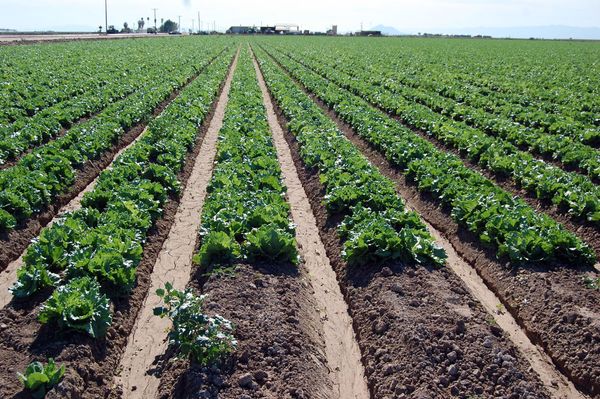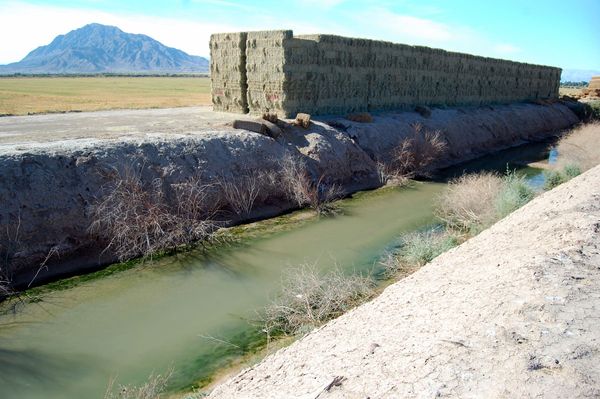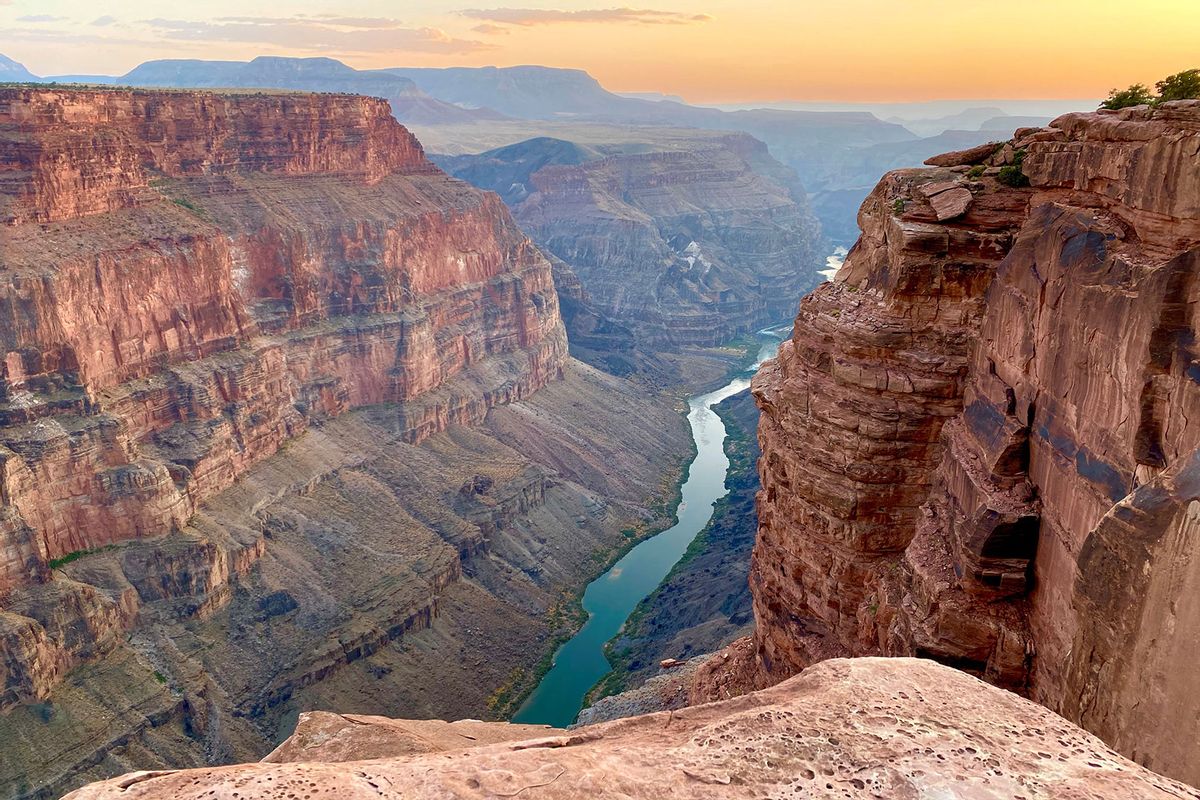The Colorado River is a 1,450-mile-behemoth, its raging waters carving their way through seven U.S. and two Mexican states. It is arguably the central attraction of the Grand Canyon, one of the world's most famous natural wonders. But it does more than look beautiful — some forty million people depend on the river for their water and hydroelectric power, not to mention the fish and wildlife who also share it with us.
But this massive river, the seventh largest in the nation, is drying up. In fact, these days it rarely even reaches the ocean anymore. This has Brian Richter, the World Wildlife Fund's President of Sustainable Waters, extremely worried. A recent study that he co-authored in the journal Communications Earth & Environment found humans are consuming so much of the Colorado River's water that they are putting it in danger. And if we don't lessen their use of the waters, the researchers warn, there could be "truly catastrophic consequences for the 40 million people that depend on this river and all those that visit."
The authors used primary data about the use of the Colorado River's ample waters from 2000 to 2019. After running the data through models with information about crops and other relevant variables, the scientists figured out a water budget based on how much water people consumed that precious resource during that timeframe. Every type of human use was considered, from agricultural and industrial uses to municipal lines bringing running water to a thirsty populace.
"There could be 'truly catastrophic consequences for the 40 million people that depend on this river and all those that visit.'"
The conclusion was "Irrigated agriculture is responsible for 74% of direct human uses and 52% of overall water consumption," the author write. "Water consumed for agriculture amounts to three times all other direct uses combined. Cattle feed crops including alfalfa and other grass hays account for 46% of all direct water consumption."
In other words, our obsession with beef and dairy is a big chunk of this equation, as Richter's previous research in Nature Sustainability has shown. The stakes could not be higher, as illustrated by the current status of the Colorado River. As the latest study describes the situation, "barely a trickle of water is left of the iconic Colorado River of the American Southwest as it approaches its outlet in the Gulf of California in Mexico after watering many cities and farms along its 2330-kilometer course."
As Richter told Salon, "Our estimates suggest that water consumption exceeds the river’s annual replenishment by about 20% over the past two decades. To make up that deficit, we’ve raided the water stored in America’s two largest reservoirs – Lake Mead and Lake Powell – and by the end of 2022 those reservoirs were three-quarters empty."
If this consumption continues unabated, millions of Americans and Mexicans in the affected areas will start to feel the strain. Water will become more scarce for food growers, leading to scarcities that will radiate beyond the immediately impacted regions. Local residents will need to start rationing water to prevent widespread shortages — and even those measures may only prove sporadically effective.
The underlying cause of this impending dilemma is, as Richter explains, "It simply takes an awful lot of water to grow our food." In fact, Richter said that roughly 90% of all the water consumed for direct human use is applies to irrigated agriculture, and Big Agriculture is not likely to relinquish its privileges any time soon. In the Colorado River Basin, for example, the farmers "hold some of the highest-priority water rights, so this dominant water use for agriculture is not likely to change too quickly, or without compensation for giving up some portion of farmer’s water rights."
Want more health and science stories in your inbox? Subscribe to Salon's weekly newsletter Lab Notes.
"It simply takes an awful lot of water to grow our food."
The farmers are not without some valid reason for feeling a sense of ownership over the river. When the Bureau of Reclamation was established in 1902, the American government paid for dams and farms to irrigate nearby farms, as well as store the spring runoff. The very concept of public use of the Colorado River implies the rights of American society's most important industry, its agricultural sector, to avail itself of its resources.
Then, in 1922, the Colorado River Compact was established so that the seven American basin states could divide the water fairly amongst themselves between the Upper and Lower Basins. So for more than a century, businesses in the American west have been taught that the government exists to help them profit from nature's resources — not impose limitations.
 Water from the Dolores River, a tributary to the Colorado River, is used to irrigate alfalfa fields near Bedrock, Colorado. (Photo courtesy of Brian Richter)
Water from the Dolores River, a tributary to the Colorado River, is used to irrigate alfalfa fields near Bedrock, Colorado. (Photo courtesy of Brian Richter)
Yet those limitations are becoming increasingly necessary. Edith Zagona, director of the University of Colorado's Center for Advanced Decision Support for Water and Environmental Systems, traces the current crisis back to the latter half of the 20th century. That was a time when previously minor population centers, either in or near the Basin, began to grow, including now-major metropolitan areas like Los Angeles, Las Vegas, Denver, Albuquerque and Phoenix. Those residents need water not just for their urban infrastructure, but for the increasing amounts of food they will need to consume from the nearby agricultural sector.
"The emergence of large urban populations has put a pressure on the use of the water," Zagona said. "Due to the priority water rights laws, farmers have had most of the senior water rights on the river. But cities are typically able to pay more for water than agriculture, so there has been a shift in water use from [agriculture] to urban due to cities buying senior water rights from farmers."
This cycle persists today. Zagona added that as states develop their water use infrastructure, they increasingly focus on urban water use, which competes with agriculture for water just as much as environmental services and Indigenous water rights.
Another variable further exacerbates the Colorado River's water depletion problem — climate change.
 More than 90% of the leafy green vegetables consumed by Americans in wintertime comes from the Imperial Irrigation District in California. (Photo courtesy of Brian Richter)
More than 90% of the leafy green vegetables consumed by Americans in wintertime comes from the Imperial Irrigation District in California. (Photo courtesy of Brian Richter)
"Hotter temperatures increase evaporation and evapotranspiration, and decrease soil moisture," said law professor Mark Squillace at University of Colorado Law School. "All of this contributes to making less water available. The loss of soil moisture is a particularly worrisome problem because it results in much less runoff into reservoirs."
When the snow melts it is absorbed by the dry soil, causing a major reduction in runoff. As a result, "climate scientist have found that the Colorado River basin is experiencing high temperature increases than other parts of the West," Squillace said.
Zagona, who described climate change models as being "conflicting in their projections about overall changes in precipitation in the Basin, [with] some projections showing more and some less on average," ultimately agreed that "the warming trend is agreed on, and will affect the runoff, i.e., the water that ends up in the river."
Richter also emphasized that climate change is a factor that negatively impacts the Colorado River's ability to serve human populations.
"Climate scientists estimate that the river has already lost about 10% of its water flow due to climate warming," Richter said. "They caution that we should expect loss of another 10 to 30% by mid-century, so the necessary reductions in water use will become greater and greater with time."
There are solutions to this problem. According to Sharon B. Megdal, director of the University of Arizona's Water Resources Research Center, the new information from this paper is not that agriculture uses a large proportion of the Colorado River's water, but rather the details of that consumption.
 Irrigation of cattle-feed crops (alfalfa and grass hay) accounts for one-third of all water consumed from the Colorado River, including within the Imperial Irrigation District of California. (Photo courtesy of Brian Richter)
Irrigation of cattle-feed crops (alfalfa and grass hay) accounts for one-third of all water consumed from the Colorado River, including within the Imperial Irrigation District of California. (Photo courtesy of Brian Richter)
"While there are opportunities to modify agricultural practices in terms of irrigation methods and crops grown, these changes will not happen overnight," Medgal said. "There are pilot projects and efforts to incentive irrigation efficiency."
Felicia Marcus, a visiting fellow at Stanford University’s Water in the West Program and an attorney and consultant for the Water Policy Group, offered more details on what kinds of projects can help people cope with the "freight train of pain coming down the climate change track."
"We need to be far more precise with our use of water for everything — urban, agriculture, industry, etc," Marcus said. "We are far more wasteful than we need to be, and modern technologies (sensors, remote sensing from space, drip irrigation and other precision irrigation, recycling, etc.) can help us get there. But we have to invest, and we have to accelerate adoption. Adaptation is the name of the game here, which requires a more clear-eyed vision of the risks vs. continuing to tinker at the edges."
She added that there are "good people" working on this problem, but that it is still important for the government to step in.
We need your help to stay independent
"The federal government’s role in helping that happen is huge — they can create the urgency that gives state and water agency negotiators the backbone, or excuse, to make the hard calls," Marcus said. "Again, it is political suicide to look like you are giving water up to someone else, or even to letting the river be a river. On the other hand, if you are forced to by the legitimate power of the federal government, there is more room to move."
There are examples of how governments — federal or otherwise — can help with the problem. In a 2022 paper for the Journal of Water Resources Planning and Management, Richter documented how "cities dependent on the Colorado River have experienced rapid population increases (+24%) but they have miraculously been able to reduce their use of water by 18%" thanks to water conservation strategies like variable water-pricing structures, turf removal and toilet replacement rebates and other plumbing retrofits.
"We need to see commensurate reductions in water use on farms," Richter said. "To accomplish this, we are going to need to help farmers make a transition to crops that require less water, and we’ll need to shrink farmland to some degree as well. We must do this smartly, with careful planning, so that we don’t lose productive cropland and impact food security."



Shares